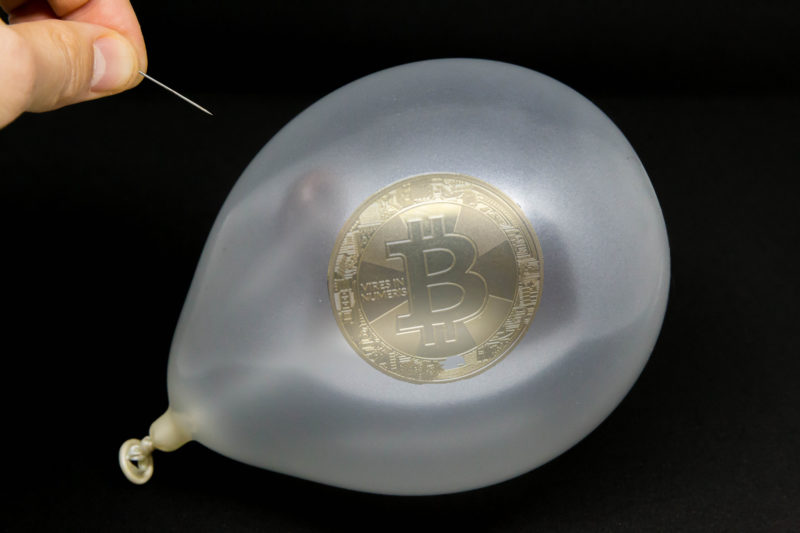Central Bank or Not, Fractional-Reserve Bitcoin Violates Sound Money

A great deal of current discussion about bitcoin and other cryptocurrencies involves technological subtleties and how they might impact existing monetary institutions. Not enough attention is paid to the basic theoretical principles underlying this evolution and the fact that those principles apply universally, with or without bitcoin.
What needs to be understood is that sound money is not dictated by the form or type of money (digital or physical), nor even by the presence or absence of central banks. It is determined by the system’s ability to curb the growth of money supply.
This means that even if something like bitcoin becomes a universal money, which I’m extremely uncertain of, this does not automatically guarantee monetary stability and soundness.
These features depend on whether the institutional and legal architecture regulating bitcoin limit the money supply efficiently or not, and these in turn depend on the correct understanding of the role of money in a market economy by the individual bitcoin actors and users.
Money can be limited in quantity, either by fixing it in advance (as is currently the case with bitcoin) or by tying it to a precious commodity with very high costs of production (as in the gold standard). But — and this is critically important — sound money also has to eliminate or reduce to a minimum practices of fractional-reserve banking and maturity mismatching, since they represent completely independent sources of monetary inflation. Because they increase the money supply by artificially inflating credit, they can produce instability with very little change in the monetary base.
If any one of these monetary malpractices is allowed to exist or even be encouraged, the cryptocurrency regime will end up in the same place where the fractional-reserve commodity and later fiat money regimes ended up: in monetary instability, boom-and-bust cycles, and asset bubbles with no end. And probably, in due course, with loud calls for government to regulate that chaos.
That this is not understood well by the enthusiasts of cryptocurrencies is seen most vividly in discussions of whether fractional-reserve banking will be possible and desirable under bitcoin. A widely accepted view is that it will be both possible and desirable. This view is encouraged by a common misconception among libertarians that the only problem with current money is the central bank, and that once we abolish government control everything is going to be fine. Unfortunately, things are not that simple.
A sound-money regime has to provide for the consistent time structure of property rights in money. That means that at every point in time, every monetary unit has to be owned by one agent or entity alone. Otherwise, the unsustainable and bubble-like patterns of investment and production will arise. People would wrongly believe that the quantity of loanable funds had increased beyond its previous limits and that the interest rates went down lower than they were. The longer and more capital-intensive investment projects would artificially look more profitable than they really are.
Herein lies the crux of the destructiveness of fractional-reserve banking and maturity mismatching. By conflating deposit contracts with loan contracts, fractional-reserve banks inflate the credit supply by allowing depositors to continue investing and spending as if their funds were immediately available, while banks use 90 percent or more of these same funds to give false promises to other people that they too can increase their investment and spending in the long run.
Fractional-reserve banking and maturity mismatching thus introduce miscommunication and miscalculation into the economic system, leading to inflated value assessments. What is even more pernicious, this inflation gets worse as the time horizon expands. The falsification of interest rates disproportionately affects the present value of longer investment projects and longer-maturity assets.
This is at the core of the well-attested phenomenon that asset bubbles are much stronger than consumer-driven price spikes, and that the prices of financial and capital assets with longer maturities increase much more during the boom than consumer prices or short-term securities and fall further during the correction.
The theoretical explanation of this is not rocket science or murky economic metaphysics. It’s just the logical, mathematical certainty stemming from the simple formula for calculating the present value of future goods PV = C/(1+i)ⁿ. The longer the time horizon, the more drastic will be the positive change in the present value of future goods as a function of the lowered interest rate.
The problem of course is that this reduction in interest rate as a consequence of the “fractioning” of bank reserves is not real, but fictitious, and hence the seemingly increased profitability of longer projects is also illusory and transient: there are not additional savings to justify this new more “roundabout” pattern of investment and production. The underlying social rate of time preference has not changed, just the credit creation, out of thin air, of simulated new savings.
The conviction often entertained these days that fractional-reserve bitcoin would be okay and very stable reflects obliviousness regarding these principles underlying money and monetary theory. It stems from an unfortunate mix of the misguided but popular libertarian obsession with “liberty” — to misappropriate monetary resources by conflating loan and deposit contracts — and essentially the Keynesian view that fiduciary “money” and created credit (Machlup’s term) are motors of economic development, rather than threats to financial and economic stability.
The assumption that money needs to be “elastic” to adjust to the “needs of trade” has traditionally been in the purview of people variously called by economists “cranks” and “crackpots,” until it was revived by Keynes and Keynesians in the 20th century. Of late, unfortunately, it has been given currency even in some liberal and libertarian quarters.
“Free banking” theory claiming that fiduciary media plays a pivotal role in maintaining the monetary equilibrium, and hence full-reserve banking is not desirable, is the canonical expression of this infection of sound-monetary theory by the Banking School and Keynesianism. The same phenomenon is also visible in the consequent, reckless acceptance of the possibility of a fractional-reserve bitcoin as a harbinger of stable and sound money.
The skepticism of bitcoin from Keynesians, shared oddly enough even by some free-banking economists, is that it is not inflationist and “elastic” enough — that it cannot be easily adjusted to the “needs of trade.” It cannot be “stretched” in a recession to save the failing banks and corporations, to “meet the increased demand for money,” to maintain a constant “nominal income,” etc.
Bitcoin, they argue, cannot perform any useful role in “smart monetary policy” and “macroeconomic stabilization.” We cannot have that.
Now, regarding the claims of bitcoin’s compatibility with fractional-reserve banking, new hopes arise for these critics: bitcoin might not be so frustratingly “rigid” after all. If it indeed could be pyramided on top of its limited supply in a fashion reminiscent of the fractional-reserve banking in the current system, then what is not to love? Meeting the fluctuating demand, satisfying the needs of trade, and all that?
It’s difficult to predict whether a global bitcoin monetary regime would resemble a 100-percent gold standard with full-reserve banking or a fractional-reserve, money-creating machine.
If the latter turns out to be the case, we will be saved neither by its digital nature nor by the fact that governments do not control it. Bitcoin without fractional reserves will be a blast; with them, it’s a bust.










